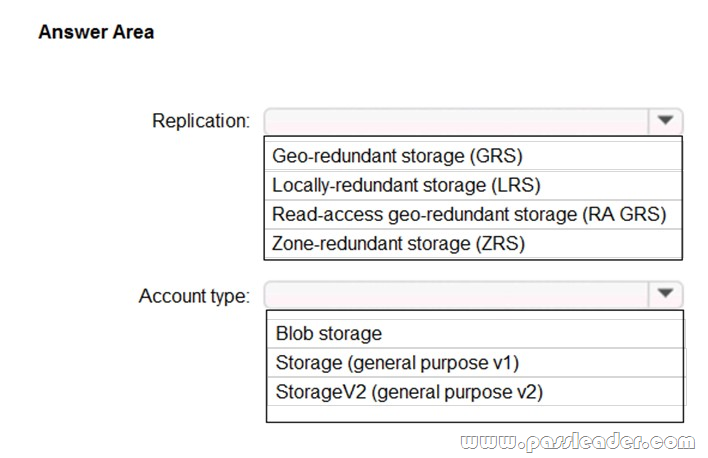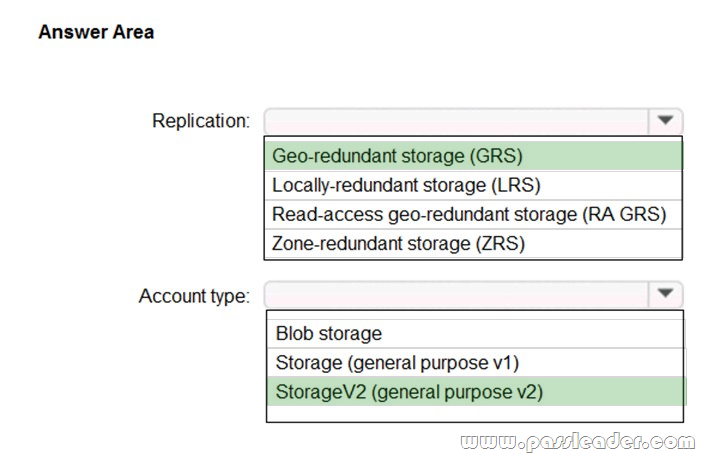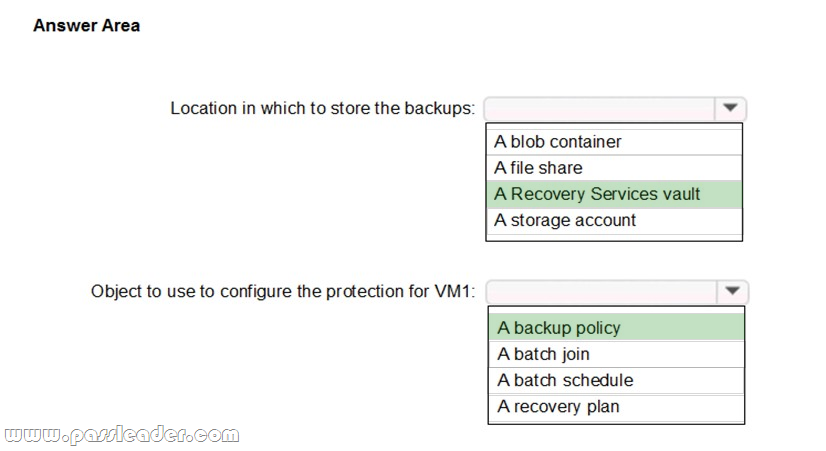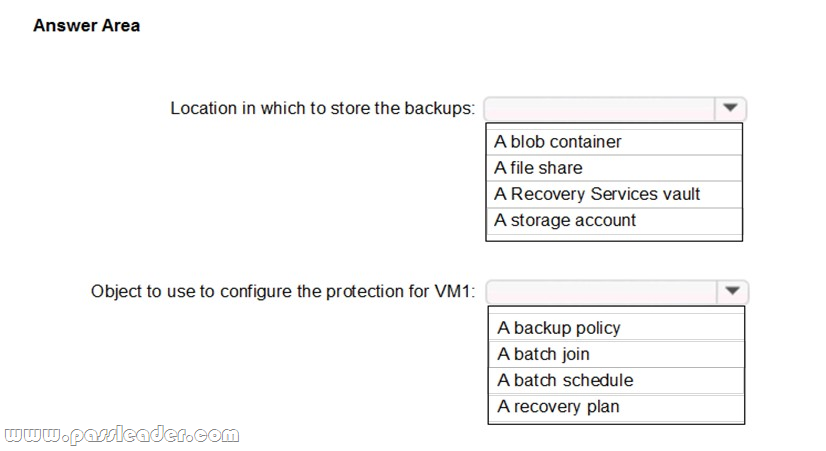Valid AZ-103 Dumps shared by PassLeader for Helping Passing AZ-103 Exam! PassLeader now offer the newest AZ-103 VCE dumps and AZ-103 PDF dumps, the PassLeader AZ-103 exam questions have been updated and ANSWERS have been corrected, get the newest PassLeader AZ-103 dumps with VCE and PDF here: https://www.passleader.com/az-103.html (309 Q&As Dumps –> 425 Q&As Dumps)
BTW, DOWNLOAD part of PassLeader AZ-103 dumps from Cloud Storage: https://drive.google.com/open?id=1pcJSvWksUYfrmRT5Hy9xnh0iGBvW_sfq
NEW QUESTION 295
You have an Azure Active Directory (Azure AD) tenant named contoso.onmicrosoft.com that contains 100 user accounts. You purchase 10 Azure AD Premium P2 licenses for the tenant. You need to ensure that 10 users can use all the Azure AD Premium features. What should you do?
A. From the Directory role blade of each user, modify the directory role.
B. From the Azure AD domain, add an enterprise application.
C. From the Groups blade of each user, invite the users to a group.
D. From the Licenses blade of Azure AD, assign a license.
Answer: D
Explanation:
https://docs.microsoft.com/en-us/azure/active-directory/fundamentals/license-users-groups
NEW QUESTION 296
You have an Azure subscription. You have 100 Azure virtual machines. You need to quickly identify underutilized virtual machines that can have their service tier changed to a less expensive offering. Which blade should you use?
A. Metrics
B. Monitor
C. Customer insights
D. Advisor
Answer: D
Explanation:
Advisor helps you optimize and reduce your overall Azure spend by identifying idle and underutilized resources. You can get cost recommendations from the Cost tab on the Advisor dashboard.
https://docs.microsoft.com/en-us/azure/advisor/advisor-cost-recommendations
NEW QUESTION 297
You have an Azure subscription named Subscription1. Subscription1 contains a resource group named RG1. RG1 contains resources that were deployed by using templates. You need to view the date and time when the resources were created in RG1.
Solution: From the RG1 blade, you click Deployments.
Does this meet the goal?
A. Yes
B. No
Answer: A
Explanation:
From the RG1 blade, click Deployments. You see a history of deployment for the resource group.
https://docs.microsoft.com/en-us/azure/azure-resource-manager/templates/template-tutorial-create-first-template?tabs=azure-powershell
NEW QUESTION 298
You have an Azure subscription. Users access the resources in the subscription from either home or from customer sites. From home, users must establish a point-to-site VPN to access the Azure resources. The users on the customer sites access the Azure resources by using site-to-site VPNs. You have a line-of-business app named App1 that runs on several Azure virtual machine. The virtual machines run Windows Server 2016. You need to ensure that the connections to App1 are spread across all the virtual machines. What are two possible Azure services that you can use? (Each correct answer presents a complete solution. Choose two.)
A. an Azure Content Delivery Network (CDN)
B. an Azure Application Gateway
C. Traffic Manager
D. an internal load balancer
E. a public load balancer
Answer: BD
NEW QUESTION 299
You have an Azure subscription named Subscription1. You have 5 TB of data that you need to transfer to Subscription1. You plan to use an Azure Import/Export job. What can you use as the destination of the imported data?
A. Azure Data Lake Store
B. a virtual machine
C. the Azure File Sync Storage Sync Service
D. Azure Blob Storage
Answer: D
Explanation:
Azure Import/Export service is used to securely import large amounts of data to Azure Blob storage and Azure Files by shipping disk drives to an Azure datacenter. The maximum size of an Azure Files Resource of a file share is 5 TB.
https://docs.microsoft.com/en-us/azure/storage/common/storage-import-export-service
NEW QUESTION 300
You have two Azure virtual networks named VNet1 and VNet2. VNet1 contains an Azure virtual machine named VM1. VNet2 contains an Azure virtual machine named VM2. VM1 hosts a frontend application that connects to VM2 to retrieve data. Users report that the frontend application is slower than usual. You need to view the average round-trip time (RTT) of the packets from VM1 to VM2. Which Azure Network Watcher feature should you use?
A. IP flow verify
B. Connection monitor
C. NSG flow logs
D. Connection troubleshoot
Answer: B
Explanation:
The connection monitor capability monitors communication at a regular interval and informs you of reachability, latency, and network topology changes between the VM and the endpoint.
Incorrect:
Not A: The IP flow verify capability enables you to specify a source and destination IPv4 address, port, protocol (TCP or UDP), and traffic direction (inbound or outbound). IP flow verify then tests the communication and informs you if the connection succeeds or fails. If the connection fails, IP flow verify tells you which security rule allowed or denied the communication, so that you can resolve the problem.
Not C: The NSG flow log capability allows you to log the source and destination IP address, port, protocol, and whether traffic was allowed or denied by an NSG.
Not D: The connection troubleshoot capability enables you to test a connection between a VM and another VM, an FQDN, a URI, or an IPv4 address. The test returns similar information returned when using the connection monitor capability, but tests the connection at a point in time, rather than monitoring it over time, as connection monitor does.
https://docs.microsoft.com/en-us/azure/network-watcher/network-watcher-monitoring-overview
NEW QUESTION 301
You have an Azure subscription named Subscription1 and two Azure Active Directory (Azure AD) tenants named Tenant1 and Tenant2. Subscription1 is associated to Tenant1. Multi-factor authentication (MFA) is enabled for all the users in Tenant1. You need to enable MFA for the users in Tenant2. The solution must maintain MFA for Tenant1. What should you do first?
A. Change the directory for Subscription1.
B. Configure the MFA Server setting in Tenant1.
C. Create and link a subscription to Tenant2.
D. Transfer the administration of Subscription1 to a global administrator of Tenant2.
Answer: C
NEW QUESTION 302
You have an Azure Active Directory (Azure AD) tenant. All administrators must enter a verification code to access the Azure portal. You need to ensure that the administrators can access the Azure portal without entering a verification code when they are connecting from your on-premises network. What should you configure?
A. an Azure AD Identity Protection user risk policy
B. the multi-factor authentication service settings
C. the default for all the roles in Azure AD Privileged Identity Management
D. an Azure AD Identity Protection sign-in risk policy
Answer: B
Explanation:
https://docs.microsoft.com/en-us/azure/active-directory/authentication/howto-mfa-mfasettings
NEW QUESTION 303
Drag and Drop
You have an Azure subscription that contains an Azure file share. You have an on-premises server named Server1 that runs Windows Server 2016. You plan to set up Azure File Sync between Server1 and the Azure file share. You need to prepare the subscription for the planned Azure File Sync. Which two actions should you perform in the Azure subscription? (To answer, drag the appropriate actions to the correct targets. Each action may be used once, more than once, or not at all. You may need to drag the split bar between panes or scroll to view content.)

Answer:

Explanation:
Step 1: Create a Storage Sync Service. The deployment of Azure File Sync starts with placing a Storage Sync Service resource into a resource group of your selected subscription.
Step 2: Install the Azure File Sync agent. The Azure File Sync agent is a downloadable package that enables Windows Server to be synced with an Azure file share. When the Azure File Sync agent installation is finished, the Server Registration UI automatically opens. You must have a Storage Sync Service before registering.
Step 3: Run Server Registration. Registering your Windows Server with a Storage Sync Service establishes a trust relationship between your server (or cluster) and the Storage Sync Service. A server can only be registered to one Storage Sync Service and can sync with other servers and Azure file shares associated with the same Storage Sync Service.
https://docs.microsoft.com/en-us/azure/storage/files/storage-sync-files-deployment-guide?tabs=azure-portal
NEW QUESTION 304
Hotspot
You plan to create an Azure Storage account in the Azure region of East US 2. You need to create a storage account that meets the following requirements:
– Replicates synchronously.
– Remains available if a single data center in the region fails.
How should you configure the storage account? (To answer, select the appropriate options in the answer area.)

Answer:

Explanation:
Box 1: Zone-redundant storage (ZRS). Zone-redundant storage (ZRS) replicates your data synchronously across three storage clusters in a single region. LRS would not remain available if a data center in the region fails GRS and RA GRS use asynchronous replication.
Box 2: StorageV2 (general purpose V2). ZRS only support GPv2.
https://docs.microsoft.com/en-us/azure/storage/common/storage-redundancy
https://docs.microsoft.com/en-us/azure/storage/common/storage-redundancy-zrs
NEW QUESTION 305
Hotspot
You purchase a new Azure subscription named Subscription1. You create a virtual machine named VM1 in Subscription1. VM1 is not protected by Azure Backup. You need to protect VM1 by using Azure Backup. Backups must be created at 01:00 and stored for 30 days. What should you do? (To answer, select the appropriate options in the answer area.)
Answer:

Explanation:
Box 1: A Recovery Services vault. A Recovery Services vault is an entity that stores all the backups and recovery points you create over time.
Box 2: A backup policy. When a new policy is applied, schedule and retention of the new policy is followed.
https://docs.microsoft.com/en-us/azure/backup/backup-configure-vault
https://docs.microsoft.com/en-us/azure/backup/backup-azure-backup-faq
NEW QUESTION 306
Drag and Drop
You have an on-premises network that you plan to connect to Azure by using a site-to-site VPN. In Azure, you have an Azure virtual network named VNet1 that uses an address space of 10.0.0.0/16. VNet1 contains a subnet named Subnet1 that uses an address space of 10.0.0.0/24. You need to create a site-to-site VPN to Azure. Which four actions should you perform in sequence? (To answer, move the appropriate actions from the list of actions to the answer area and arrange them in the correct order.)

NEW QUESTION 307
……
Get the newest PassLeader AZ-103 VCE dumps here: https://www.passleader.com/az-103.html (309 Q&As Dumps –> 425 Q&As Dumps)
And, DOWNLOAD the newest PassLeader AZ-103 PDF dumps from Cloud Storage for free: https://drive.google.com/open?id=1pcJSvWksUYfrmRT5Hy9xnh0iGBvW_sfq

